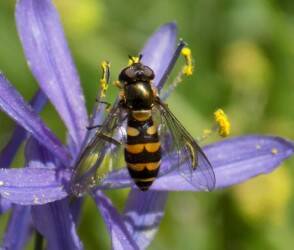By Russel Barsh
Director of Kwiaht
Gardeners, farmers and admirers of wildflowers in the islands are fortunate that we still have nearly a hundred species of wild native bees to ensure pollination. But that is only half of the story. We benefit greatly from a second major group of wild pollinators: the flower flies, or hoverflies as they are known in Canada and the UK. As many as a hundred and fifty species can be found in our area, mostly native to North America, together with a few relatively well-behaved European newcomers.
Flower flies are often conspicuously noisy, brightly colored and assertive, mimicking bees and wasps to deter predators. Many look just like yellowjackets, some like bumblebees, and some like the tiny black wasps that parasitize other insects. But look closely and you will see their large, round fly eyes that take up most of the head. More critically, you will see that most flower flies have short, stubby, club-shaped antennae, easily distinguishable from the long tubular antennae of bees and wasps. Watch closely, and you will see flower flies (and other families of flies) shake their little antennae to “sniff” the air; whereas Bees and wasps poke things with their antennae to “taste” them.
Like most other adult flying insects, flower flies visit flowers periodically to lap up nectar: refueling with this sugary bait. Like bees, however, flower flies also eat some pollen during their flower visits, and they tend to have some fine bristles and hairs on their faces, bodies and legs that pick up a dusting of pollen grains that the fly unwittingly transports to the next few flowers it visits. Flower flies are less systematic and rather haphazard in their choice of flowers they visit, however. This is because, unlike bees, flower flies do not have nests or larvae to provision. They do not collect and store pollen, which is an incentive to visit more flowers each day, and focus on flowers with the greatest pollen payoff. Yet while flies are inefficient pollinators compared to bees, they vastly outnumber bees in temperate ecosystems, so they tend to pollinate about as many flowers, in total, as bees do.
If flower flies have no nests, where do their eggs go? This brings us to the true beauty of these colorful flies for gardeners. Flower flies of the family Syrphidae lay their eggs on plants that have been attacked by aphids. When they hatch, the larval flies gorge themselves on aphids until they metamorphose into nectar-and-pollen-eating adults. And because they do not have fixed nest locations, flower flies wander and lay small batches of eggs over long distances. Some species can travel hundreds of miles over the course of a summer, laying eggs on aphids all the way.
One of our most common flower flies in the islands is Syrphus ribesii, whose scientific names suggests that it specializes on flowers of the genus Ribes (currants and gooseberries). But that is misleading. We find this fly on many native and introduced shrubs, including snowberries and roses, as well as orchard trees, as well as native wildflowers such as Camassia quamash in this photo taken at American Camp. You may see it in a wildflower meadow, or in your garden, from early spring to early fall. And like other flies, it neither stings nor bites. Unless you are an aphid, you have no reason for concern!
The tiny slug-like larvae of flower flies are not to be confused with the invasive European sawfly that lays its eggs on young leaves of currants in spring. Sawfly larvae have long caterpillar-like bodies, with six tiny legs just behind the head, which has distinct eyes. Flower fly larvae are short, pear-shaped, slug-like and lack a distinct head or eyes. It’s fine to squish sawflies, but be sure to leave your flower fly larvae free to help rid your garden of aphids before they pollinate your flowers.




